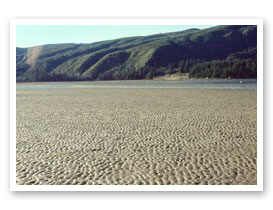 INSTITUTE FOR NATURAL RESOURCES
INSTITUTE FOR NATURAL RESOURCESYou are here
Wetlands
Land Use and Planning
- Intro
- Planning Resources
- Research Projects
- Articles & Stories
- Maps & Tools
- Reports & Publications
- Data
- Photos & Videos
- More
Historical Loss of Wetlands
Estimates of wetland loss in Oregon since 1850 vary by region and data source. Statewide, 38 percent of wetlands are thought to have been converted to other uses (Dahl 1990). Losses in various regions of the state vary from 57 percent in the Willamette Valley to 91 percent in the Klamath Basin, while losses for individual coastal estuaries range from 2 to 94 percent (Good 2000; Morlan 2000). Losses for particular rare wetland types such as wet prairie or peatland in the Willamette Valley range from 99.5 to 98 percent, respectively, and 88 percent of tidal spruce swamp has disappeared from the coast and lower Columbia River (ORNHIC).

Mudflat at Netarts Bay
(Heather Stout)
Existing regulatory programs have slowed but not stopped the loss of freshwater wetlands in Oregon. Estuarine wetlands are almost all protected by current land use laws, and impacts have been greatly reduced from what they were 30 years ago. However, rising sea levels associated with climate change may already be causing irreversible changes to these wetlands. Overall, wetland restoration programs are helping to reduce losses, and in some areas are making net gains in wetland acreage, but much work remains to be done to protect our wetlands.
For documentation of wetland trends in Oregon and nationally, the information is accessible from the Monitoring Trends page.











